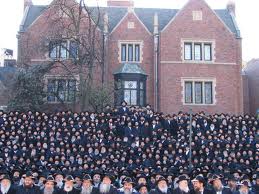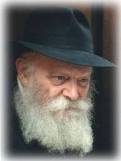 “One of the reasons we started doing this is because there’s so much misinformation out there about the Hassidic community,” says Rabbi Beryl Epstein, tour guide for a busload of visitors that leaves midtown Manhattan for 770 Eastern Parkway, headquarters of the Lubavitch Hassidic movement in the Crown Heights section of Brooklyn.
“One of the reasons we started doing this is because there’s so much misinformation out there about the Hassidic community,” says Rabbi Beryl Epstein, tour guide for a busload of visitors that leaves midtown Manhattan for 770 Eastern Parkway, headquarters of the Lubavitch Hassidic movement in the Crown Heights section of Brooklyn.
During the 45-minute trek to Brooklyn, Rabbi Epstein describes the two-century-old Hassidic movement, its charismatic founder the Baal Shem Tov, and the present Lubavitch sect, which has some 250,000 followers worldwide. It is one of more than 200 Hassidic movements still operative today, remnants of a devastated European Jewish community that was once at least 60 percent Hassidic.
A cluster of 10,000 to 15,000 Lubavitchers live in Crown Heights, a burgeoning community in which children outnumber adults by two to one. The neighborhood is already crowded to capacity: the demand for living space is so high, and local vacancy rates so low, that competing ethnic groups play tug-of-war over each newly available house and apartment.
Rabbi Epstein discusses the seventh Lubavitcher Rebbe, Menachem Mendel Schneerson, who died without a successor in 1994, but he expertly dodges the controversial question of whether he is the Messiah, as many Lubavitchers believe. “Let’s leave that until later,” he suggests. A wise and congenial host, he’s conducted this tour for 15 years, and he knows where the potholes lie. A native of Chattanooga, Tenn., he also knows the locations of the main Jewish restaurants, synagogues and other landmarks of the Big Apple, a few of which he points out as we cross the Lower East Side.
Soon after we cross the Brooklyn Bridge we reach 770 Eastern Parkway, a large elegant brownstone building in which the Rebbe had his office. Once, the Jewish multitudes would line up outside to receive his blessings; he also gave out dollar bills, which the recipients understood they were to supplement with dollars of their own and give to charity.
We enter the vestibule. Rabbi Epstein says that Rabbi Schneerson called 770 Eastern Parkway “the Beit Hamigdash of the Exile” because he saw it as the most holy building for the Jewish people anywhere, at least until the rebuilding of the Temple. He talks about Rabbi Schneerson’s great powers of prophecy — relating, for instance, that he correctly predicted when and how the Gulf War of 1991 would end.
“Who is the rebbe now?” someone asks.
“That’s an excellent question,” he replies. “I’ll save that question for later.”
A large building next door is the organizational home of the Lubavitch movement and the nexus of its vast outreach network of 2,500 representatives who bring Torah, charity and Yiddishkeit to many outposts around the globe. Inside is a large prayer sanctuary. From the visitors’ gallery, we look down and see about one hundred worshippers arranged in several groups; new services begin whenever a necessary quorum of ten men is reached. A banner on the wall proclaims Schneerson as the Messiah in big Hebrew letters but fortunately for Rabbi Epstein, nobody requests a translation.
Around the corner is a remarkable library featuring display cases that hold a yamulke of the revered First (“Alter”) Rebbe, Schneur Zalman of Liadi, and many documents in his handwriting. Also under glass are several extremely rare handwritten copies of the Alter Rebbe’s holy mystical tome, the Tanya. The library also holds the world’s largest collection of Haggadot.
The tour concludes with a kosher lunch at a local deli. Understandably, we do not visit the Rebbe’s gravesite some 15 km away in Queens, which has become a shrine for the faithful; it is not for tourists.
During the return to Manhattan, our host answers more questions, including one about the Satmar of Williamsburg. Briefly, he talks about these Hassidim, who are as introverted as the Lubavitch are extroverted, and who, perversely, do not recognize the Jewish state of Israel. Why, someone else asks, does Rabbi Epstein always refers to the late Rabbi Schneerson in the present tense? “We talk about all great Jewish leaders that way, including Moshe Rabbeinu,” he explains. “It’s because they are still living for us.”
The Hassidic Bus & Walking Tour costs $36, including lunch, and leaves Sundays from the New York Public Library and other spots in Manhattan. Departs 9:30 a.m., returns 1:30 p.m. Weekday tours also available. Reservations highly recommended. 800-838-8687. www.jewishtours.com. ♦
© 2000
 SCHNEERSON WAS A CHARISMATIC LEADER
SCHNEERSON WAS A CHARISMATIC LEADER
Some call him the Messiah of Brooklyn and there’s no question that Rabbi Menachem Mendel Schneerson, otherwise known as the seventh Lubavitcher Rebbe, was an effective and charismatic Jewish leader.
He died without a successor in 1994 at the age of 92, leaving behind an estimated 250,000 followers, including many who regard him literally as the Messiah. But the claim has been hotly disputed and caused a wide schism within the two-centuries-old movement.
The US Congress posthumously awarded him a congressional gold medal for his contributions to society, and a recent poll in the high-circulation London Jewish Chronicle named him as “Jewish newsmaker of the century.”
During his 44-year reign, Rabbi Schneerson built Chabad Lubavitch into a powerful Jewish outreach organization with some 2,500 representatives in 50 countries. Especially after the fall of communism and the “miracles” of the Gulf War, he felt the world had entered a messianic age and so he daily exhorted his followers to do good deeds to hasten the coming of “Moshiach,” the Messiah. A bearded man whose trademark dress was a black waistcoat and black fedora, he never publicly claimed to be the Messiah. Still, one wonders how strongly he resisted the many proclamations to that effect that must have reached his ears before he was felled by a stroke in 1992.
Whatever their view on the Moshiach issue, most Lubavitch-affiliated Jews in Brooklyn, Israel and elsewhere still look to the Rebbe for spiritual guidance and direction. It is almost a commonplace for his picture to hang in their homes, synagogues and commercial establishments.
“The Rebbe is still the leader of our generation,” says Rabbi Joseph Zaltzman, who came to Toronto at the Rebbe’s behest in 1981, and is now spiritual leader of the city’s 35,000-strong Russian-Jewish community. “In many ways his leadership is much stronger, much more real today than anyone else’s. I think he’s still the most influential Jewish leader in the world today.”
“The Rebbe gave us a job to do,” says Rabbi Zushe Silberstein, director of the Lubavitch-run Chabad House in downtown Montreal, “and we’re doing it with the same spirit and the same enthusiasm as when he was with us physically. Because everyone feels that he is still with us spiritually.”
Stories abound of amazing and miraculous occurrences attributed to the Rebbe. Many say they still communicate with him via his many published works. “One can write a letter and put it anywhere in any of his books, and you can bet that you’ll have an answer to your question,” says Rabbi Silberstein. Wanting assurance that his soon-to-be-married daughter had chosen a suitable mate, Rabbi Silberstein inserted a letter into one of the Rebbe’s books at random. “On that page the Rebbe was talking about the marriage of a woman to a groom with the same name as my daughter’s fiancee,” he says. “So I knew I had my answer.”
While the Rebbe lived, the multitudes would line up to receive his blessing outside Lubavitch headquarters at 770 Eastern Parkway in the Crown Heights neighborhood of Brooklyn. In his later years he would give out dollar bills, which the recipients understood they were to give to charity, supplemented by dollars of their own.
Five and a half years after his death, his gravesite in the New York borough of Queens has become a shrine to which the faithful are drawn in an unending parade around the clock. Scores of letters and prayers still arrive daily for him by mail and by fax, and are read to him at his tomb.
Many are convinced that he never died at all or that he will return from the dead to complete his divine mission. They spread their good news through billboards, posters, newspaper advertisements, radio broadcasts and the Lubavitch-operated “mitzvah mobiles” which roam Jewish neighborhoods in various cities (including Toronto) and blare festive music at Hanukkah and other holidays.
The messianists hold the upper hand at 770 Eastern Parkway. They have incorporated messianic prayers into the Sabbath prayer service and festooned the main sanctuary with a large banner whose Hebrew message reads: “Long live the Rebbe, King Moshiach, forever and ever.” These and similar actions sparked a rancorous behind-the-scenes battle. Ultimately, those disputing the Schneerson-as-Moshiach claim, including many Lubavitch officials, felt compelled to leave and establish another congregation nearby.
The Rabbinical Council of America, a 1,000-member body of Orthodox rabbis, also opposes the messianists. In light of what it described as “disturbing developments” in the Jewish world, the Council passed a resolution strongly refuting the notion that any messiah could “begin his Messianic Mission only to experience death, burial and resurrection before completing it.” That, according to the Council, which has the backing of the Talmud and the revered medieval sage Maimonides, is simply not the prophesied scenario through which the world may expect to be redeemed.
Although it is rare for one Jewish Orthodox group to publicly criticize another, Rabbi David Berger, who penned the Council’s resolution, asserted that the rebuke was necessary. The alternative, he says, was to risk “altering the basic contours of the faith.”
Was Rabbi Schneerson an extraordinary man or was he more? The answer is just “ideological shading,” says Rabbi Eli Cohen, director of Chabad at New York University. “I feel completely comfortable with the friendships I have with people who don’t see every aspect of the ideology 100 percent the way I do,” he says. “That’s true for everyone in the movement.
“You’re dealing with very fine theological and spiritual lines which don’t translate well into copy in a newspaper,” he continues. “When someone is quoted in an article, it always seems that they overstate their positions. But it’s really a fine line of difference between those with a more spiritual view of the situation as opposed to those with a slightly more pragmatic view.”
Despite the current split, the movement does not risk falling apart soon, he says. “It really is one unified movement, even if there are some ideological and more practical issues on which people don’t see eye to eye. There are many thousands of people all over the world who feel compelled by the Rebbe’s mission of bringing Judaism alive, whose lives have been improved and who have benefited enormously from their interaction with the Rebbe and his movement. That is still going on.”
LUBAVITCH LORE
When his father-in-law and cousin, the sixth Lubavitcher Rebbe, died 50 years ago this month, Rabbi Menachem Mendel Schneerson (1902-1994) became the seventh leader of the historic Chabad Lubavitch rabbinical dynasty.
The name Chabad is a kabbalistic acronym derived from the Hebrew words Chochmah (wisdom), Binah (understanding) and Daat (knowledge). Lubavitch is a town in Russia with which the movement was long associated.
Chabad Lubavitch is one of dozens of Hassidic movements founded in Russia in the late 18th and early 19th centuries in the wake of the charismatic reformer, the Ba’al Shem Tov, who taught that the Jewish masses could get close to the Almighty through song, dance and joyous prayer, not just intellectual study.
Adhering to strict observance of Jewish law as laid down by the Torah, the movement differs from other modern Hassidic groups by its strong outreach programs. A fringe movement of mainstream Judaism, the sect has an estimated 250,000 followers, representing about two percent of the world’s Jewish population. ♦
© 2000








